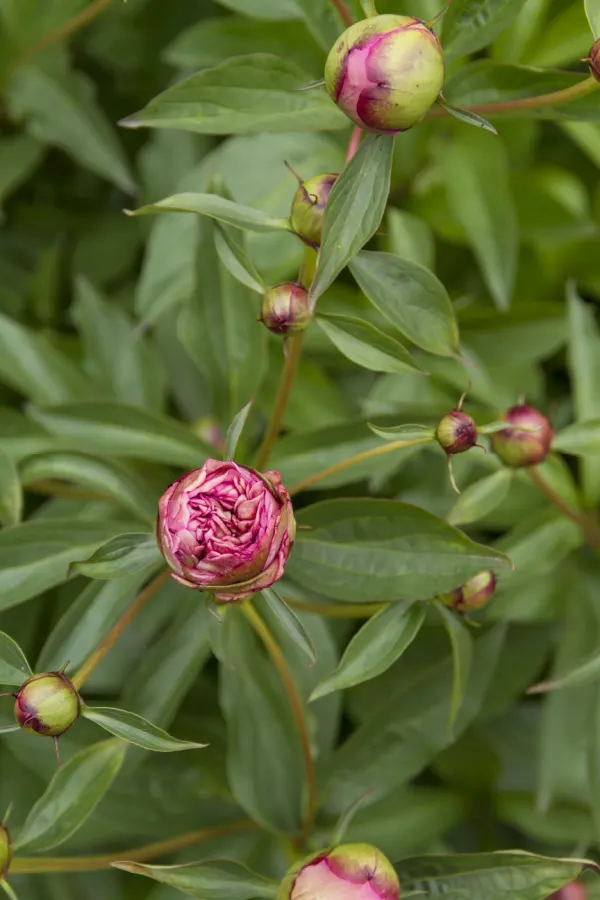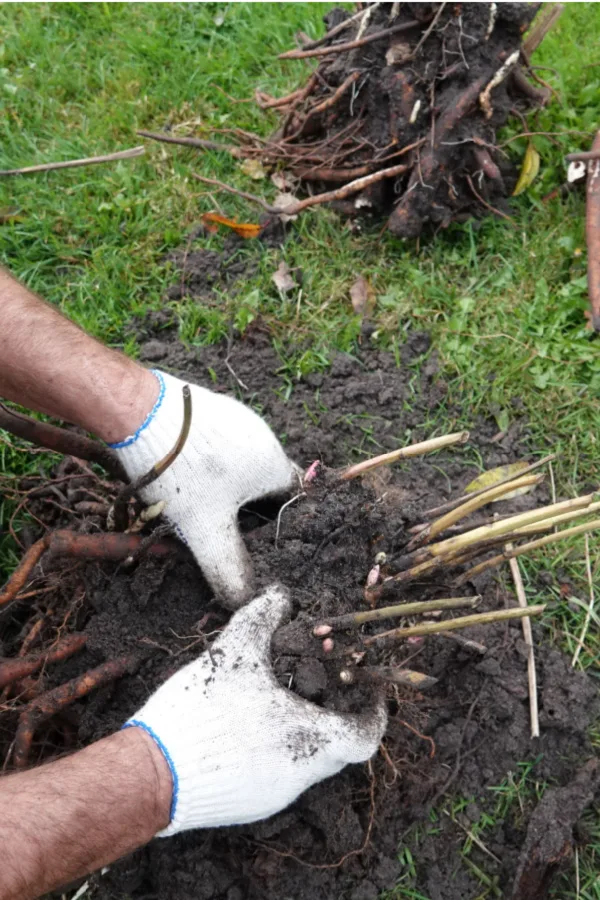If your peonies have grown a bit too large for their space and are beginning to look tired and worn out, it’s time to divide them this fall to give them a fresh new start for next spring and summer!
Peonies are one of the first big blooming bushes of the season. They burst forth with their huge flowers just as spring begins to hit full stride – coming into bloom in most climates somewhere between mid-May and early June.
When they are healthy and vibrant, peonies create a floral display like no other. With their massive single or double flowers that bloom in a wide variety of hues in pink, white or red, they are perfect for bringing big life to flowerbeds. And they also happen to make an incredible cut flower as well!

It is true that you do not have to divide peonies. But there are some big advantages to doing so. Especially if they have grown to the point where their roots become tangled, crowded and tired. When this happens, not only does the plant’s health suffer, it can also lead to far less flowers with each passing year. Or in some cases, no blooms at all!
More Reasons To Divide Peonies On A Regular Basis – How To Divide Peonies In The Fall
There are a long list of benefits for dividing peonies that go beyond simply keeping the roots from becoming overcrowded.
First and foremost, smaller peony clumps are easier to care for. They need less water and nutrients to thrive, so you’ll spend less time tending to them. Even better, they tend to be easier to support. When peonies get too large, the heavy flowers and stems often topple over to the ground.
In addition, dividing every three to five years also helps keep a handle on pests and disease. The larger and more overgrown a peony becomes, the more easily pests can hide. And if the foliage grows too large and thick, it’s also easier for mold, mildew and other diseases to find a home.

Maybe the best reason for dividing regularly is that you get free plants! Peonies are not exactly inexpensive to purchase. But by dividing your own stock, you can create plenty of new plants to use all over your landscape – all without spending a dime in the process.
Finally, another advantage to creating new plants is being able to share them. Gifting them to friends and family or swapping with other gardeners makes for a unique and thoughtful gift – and a great way to add new and interesting flowers to your landscape as well.
With that in mind, here is an in-depth look at how to divide peonies and why fall is the best time of all for the task!
How To Divide Peonies In The Fall
Why Fall Is The Best Time To Divide
Fall is by far the best time to divide peony plants, and for several key reasons. During fall, peonies slow their growing habits in anticipation of becoming dormant. Because of this slower growth, it makes the bush far less vulnerable to transplant shock.

Dividing peonies in the fall also more importantly allows ample time for newly separated roots to establish themselves before winter arrives. Doing this in the spring is risky enough, but summer is even more dangerous.
Unfortunately, transplanting in the spring or summer simply brings far too much stress to plants. When divided in the spring, the energy the plant uses to re-establish its roots takes a lot of power from the plant. Because of this, the plant doesn’t have enough energy left for producing blooms or flowers.
In the summer, the intense heat and lower moisture can make it almost impossible for the plant to establish. Even peonies that are lucky enough to make it often will not flower the following season.
The stress is enough that it often leads to the plant’s total demise in the summer. So if you want to divide your peonies – fall is the time!
The Simple Steps To Dividing Peonies In The Fall
Before dividing your peonies in the fall, the first step is to cut the bush down to within a few inches of the soil line. This will allow you to find the root system far easier. In addition, it will stop the plant from trying to send resources to old growth and redirect energy to its roots.
With a large shovel, begin digging in a straight, downward motion. Typically, peony roots are about 6 to 8 inches deep. Start by slicing down around the outside of the circumference of the plant. Next, dig down on a bit further to go under the roots and carefully lift the entire plant out of the ground.

To remove excess debris, you can gently set the large root system on the ground to loosen up any soil. You may notice some tubers naturally breaking off and dividing. Once on the ground, depending how large your roots are, you may be able to separate off tubers by hand.
Try to keep tuber portions in similar size. This will allow the new plants to grow to the same size and be even in your landscape. A general rule of thumb is 3 to 5 inch tuber portions will create a 1 to 2 foot peony bush.
To break up more sturdy roots, you may need to use hand tools. A garden knife or a small folding saw are both great for this. Simply wedge through the thicker roots and cut to your desired cluster size. Affiliate Product Link: Hori Hori Garden Knife
Transplanting Peony Bushes – How To Divide Peonies In The Fall
You can transplant your peonies into a traditional ground space or even into pots for a unique spring and summer container display. Either way, transplanting as soon as you dig your plants up is the first key to success. The longer the tubers are out of the soil, the more they will dry out.
Flowerbed Transplants – How to Divide Peonies In The Fall
For garden transplants, it is important to transplant into fertile, well-draining soil. Begin by amending planting holes with compost. Dig down to a depth of around 12 inches to loosen the soil, then mix in equal amounts of compost and soil in the bottom 4 inches of the hole. (See: Making Great Compost)

Next, set your tubers in the planting hole to around 6 to 8 inches deep. Make sure the tips are pointing upward as you plant. Plant so that just the tips of the peonies are poking through the soil and barely visible.
To finish, cover the top of your peony tubers that are sticking through the soil with mulch. Eventually the new growth and stems will grow through the mulch, but the covering will protect the plant through winter.
If you are putting into pots you will need to protect from winter by moving into a garage or warmer location.
When transplanting into a planter, make sure your newly divided plants are placed in no smaller than a 3 gallon pot. This gives the roots room to grow and gives the peonies a much better chance of blooming well.
For potted transplants, do not plant too deep. This gives the plant room to grow stronger roots in the soil. Also, be sure not to over water your potted plant. These do not need as much water as other traditional potted plants and can suffer from overwatering.
Here is to dividing and creating a few more peony plants for your landscape this fall – and all for free!
Follow Our Facebook Page For Even More Great Tips! Simple Garden Life Facebook Page
Simple Garden Life is a website dedicated to keeping gardening fun, simple and enjoyable! We publish two new articles each week along with a new garden podcast episode every two weeks. This article may contain affiliate links.
